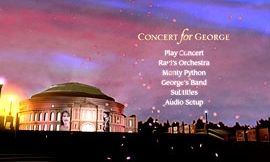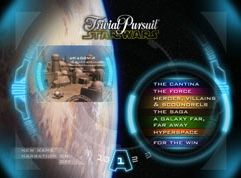DVD menus
Four motion graphics specialists show us what's on their menus...
Although of ten overlooked by many skipping to the main feature of a DVD, the motion menus play an intrinsic role in how we relate to a title and are central to the way in which we navigate around extra features, commentary tracks and trailers. The design and creation of these menus is a complex process which can take months to achieve, and the more ambitious they are in scope, the more the companies that create the graphics, animations and other elements have to put in.
Case Study 1
Abbey Road Interactive: Concert for George
Award-winning Abbey Road Interactive's recent Concert for George saw the design group entirely rebuild the iconic Royal Albert Hall...
Based in what could easily be described as the most famous recording studio in the world, it's little surprise that the EMIowned Abbey Road Interactive has a long and successful pedigree as a leading developer of music-based DVDs.
With a portfolio ranging from the Coldplay Live concert film and a greatest hits package for current rap flavour of the month 50 Cent, to massive projects such as the six-disk Beatles Anthology overview, Abbey Road Interactive is at the forefront of menu design - something that has been recognised by a number of industry awards.
The company's most recent project, Concert for George, was no exception, scooping the Best Long Form Music Video award at the 2005 Grammys. For this special commemoration film - a project obviously very close to the hearts of the staff at Abbey Road - the group was asked to design the main interface around the famous Albert Hall venue where the concert was staged.

Chief Designer Mark Warner says the company's main method of working is to start with a client meeting and then design a basic flowchart of content, music and structure.
"This will then be taken away by the designer and worked into a visual storyboard, showing how the disc will look, animate and function," says Mark. "After discussing the storyboard with the client, any changes are made and the menu production process begins."
Get the Creative Bloq Newsletter
Daily design news, reviews, how-tos and more, as picked by the editors.
The next step, which involves creating the menus we see in the finished product, is a little trickier. "After initial designs in Photoshop, the elements of the disc will be composited together in After Effects, adding motion effects and filters. These are then rendered out into bitmap sequence files and audio files for encoding into moving menus and transitions. A build is then made of the DVD and is checked for functionality and any changes needed are made at this point or after a client has seen the emulation," says Mark.
http://www.abbeyroadinteractive.com
Case Study 2
Vision Wise: Star Wars Trivial Pursuit
Taking almost a year to complete, West Coast-based menu specialist Vision Wise's work on a Star Wars DVD version of the Trivial Pursuit game was certainly a tough challenge...
Working in the independent film, TV, animation and games sectors, Dallas-based Vision Wise has been steadily carving itself a niche in the competitive interactive design and motion menu space over the past few years for clients ranging from Picture This Entertainment to gay web community group PlanetOut.com.

The company has worked on a wide and varied number of projects but always starts a project from the same place, according to Lead Designer Jamie Cameron, by establishing the assets it has to work with and the amount of creative freedom the client is prepared to give. "Once that has been established," says Jamie, "we watch the content of the DVD, looking for subject matter, purpose, style, mood, main characters, and audience. With this information we brainstorm, either individually or as a group, then do rough sketches in Photoshop, and sometimes After Effects, of several looks for the client to choose from, including highlights, video effects, and compositing."
Once this has been completed, the creation of the actual menus begins, according to Jamie, by laying out designs in Photoshop and then adding captured video, stills and audio assets. "Separate Photoshop files are then set up for each menu for animation in After Effects," explains Jamie.
"Once this has happened we experiment with effects, layering, compositing and animation to come up with the final motion of the menus," continues James. "Length of menu music usually determines the length of our menu loops. At this point we'll also design and animate any transitions that are needed. Once we have a look we're happy with, we set up and animate all of the menus. We usually plan on several rounds of approval to make sure the client is happy with the flow of the work."
Case Study 3
The Pavement: Little Britain
London-based The Pavement has handled everything from cult films and stand-up gigs to greatest hits packages and, one of 2004's best-selling comedy titles, Little Britain...
Representing the best of UK talent in the motion menu design business, London-based The Pavement is one of Europe's best known and award-winning DVD production houses, and it has quickly gained a reputation with clients in the film, music and television industries.
Founded in 2000 by Andy Evans, Kristen O'Sullivan and Lloyd Shaer, The Pavement has grown quickly through a number of high pro. le projects which have recently included a Scissor Sisters concert film, a Stone Roses compilation, a live film for comedian Jimmy Carr and popular UK cult cross-over movie Shaun of the Dead. The company has also recently produced motion menus for Little Britain - the runaway TV success of 2004 which has proved ridiculously popular on DVD.
Mike Sharpe, Pavement's Senior Designer, says the most important part of developing menus for projects such as Little Britain is to "sit down and watch."
"It's important to not try and come up with ideas quickly, because at this stage you should just mull it over," begins Mike. "It's often nice to get stuff early, watch it and leave it for a few days to marinate in the back burner. I spend a lot of time watching, listening, researching and surfing to really get inside a project before I jump into the computer and start designing."
From the ideas stage, Mike says the next important step to take is thinking about how the navigation and style of the disc will work throughout.
"It's no use coming up with just a really nice main menu; you need to think how the main style can be adapted and furthered into the secondary menus and so on. Often it's a good idea to sketch down how you see the disc working in a rough flow chart and talk it through with the producer at all times," says Mike.
Case Study 4
Blink Digital: Ghost in the Shell
From conception to storyboards to "lots of client meetings", veteran menu producer Erika Offutt and Blink Digital know all about developing projects for a range of clients, including the fast-moving world of anime...
With a history in DVD motion menu design stretching back to the mid 90s, Erika Offutt has been involved in a wide number of projects mainly in the anime space. Now working for Santa Monica based Blink Digital - a well-established digital design agency with a wide range of clients - Offutt is working on a number of projects including one for MTV and the recently completed anime title Ghost in the Shell.
For Erika Offutt, the menu process begins with a client meeting, discussion and screening to give her an idea of the scope of the project. Once the preliminary discussions have taken place she can begin conceptualising, a process which usually involves Offutt presenting clients with storyboards of motion concepts or small QuickTime films of ideas.
Once the menu concepts have been developed and approved by the client, Erika begins the process of creating sub picture or highlight buttons - the areas on screen used to navigate through the DVD. At this stage she also adds audio tracks - although this may not always be the case. "For the most part, audio is put together with the menus after they are created but there are some instances where working with the audio while designing is beneficial. For example, when you'd like to cut video to match the beats of the music," she says.
The final stage of the process is encoding the motion menus and audio and sending them off to an author who will program them for functionality.
The working relationship Erika has with clients can vary greatly. "There are some I have developed a relationship with over the years who have come to trust my design instinct. Other clients like to be very hands-on and involved in the design process. This can mean many meetings, phone calls, and emails to toss ideas around," she says.
Getting into DVD motion menu design
The DVD industry is in a state of growth at the moment and there are lots of opportunities for people with the right experience and, more importantly, attitude. "It's all about energy: you've got to really want to do it. It can be a lot of fun and hugely rewarding, but there's a lot of work involved to get to there," says The Pavement's Mike Sharpe. "When I started out I went to see everyone, not just people looking to hire. Find out and research the companies that you would love to work for and go for it. Put your face about, try and get in to see someone and get another name from them and so on." "I would say seek out a company that you'd like to be part of. If that means starting at the bottom and working your way up, do it," advises Erika Offutt. "Anyone with the skills, ambition, and drive can and will succeed in what they set their mind to," she says.

Thank you for reading 5 articles this month* Join now for unlimited access
Enjoy your first month for just £1 / $1 / €1
*Read 5 free articles per month without a subscription

Join now for unlimited access
Try first month for just £1 / $1 / €1
The Creative Bloq team is made up of a group of design fans, and has changed and evolved since Creative Bloq began back in 2012. The current website team consists of eight full-time members of staff: Editor Georgia Coggan, Deputy Editor Rosie Hilder, Ecommerce Editor Beren Neale, Senior News Editor Daniel Piper, Editor, Digital Art and 3D Ian Dean, Tech Reviews Editor Erlingur Einarsson, Ecommerce Writer Beth Nicholls and Staff Writer Natalie Fear, as well as a roster of freelancers from around the world. The ImagineFX magazine team also pitch in, ensuring that content from leading digital art publication ImagineFX is represented on Creative Bloq.
